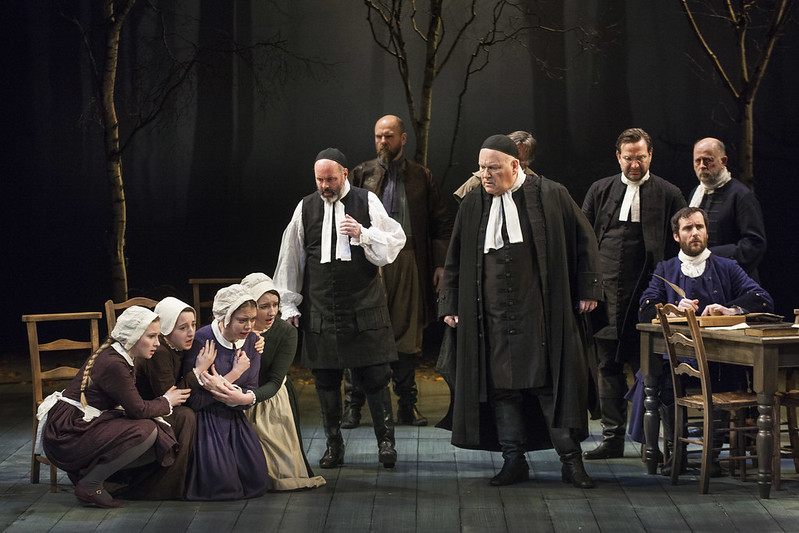As Halloween draws near, images of witches and broomsticks enter our minds again, symbols of fear and fascination. But the representation of witches cannot be reduced to a costume – they have been written about for centuries, typically as an ugly and unruly threat, a vision of what a woman should not be. The message is clear: female power is destructive and deserves to be punished, though over time the role of the witch has been re-examined and re-defined.
The Weird Sisters of Shakespeare’s Macbeth embody the archetypal witch, representing evil, chaos and darkness, and deviating from ideals of femininity through their beards and ‘wither’d’ appearance. Shakespeare clearly exploits the hysteria surrounding witchcraft at the time: he wrote Macbeth shortly after the North Berwick witch trials of the 1590s. The Weird Sisters adhere to contemporary fears of witchcraft, particularly through their cruelty and control of the elements, and so are perhaps products of oppressive ideas. However, as agents of fate, their power over the plot and the male characters displays a level of female autonomy that was inconceivable for most women in 1606. Equally, their connection with Hecate and the three Fates draws on a classical network of female authority.
This subversion is not so clear in Grimm’s Fairy Tales, or the Children’s and Household Tales, as the iconic witch of ‘Hansel and Gretel’ is punished for her inversion of the maternal ideal. However, in Bronte’s Jane Eyre, filled with elements of the fairy tale, the witchy and supernatural seem to suggest resistance to patriarchy: Jane labels herself ‘half fairy, half imp’ in a moment of defiance. Her prophetic dreams and visions connect her to Bertha, creating a link with female opposition and disruption. The epithets that describe Jane (‘elf’, ‘witch’, ‘changeling’ and ‘fairy’) empower her through a sense of spiritualism – she ‘bewitched’ Rochester’s horse, undeniably asserting a mystical influence.
This marks a shift in the idea of the witch as a villain, certainly reinforced by L. Frank Baum’s The Wonderful Wizard of Oz, in which both Glinda and the Good Witch of the North feature as heroic and powerful with positive intentions. Glinda was supposedly inspired by the abolitionist and suffragette Matilda Joslyn Gage, Baum’s mother-in-law, whose book Woman, Church, and State (1893) argues that witch trials were caused by anxieties surrounding female power and its threat to the patriarchy. Of course, The Wonderful Wizard of Oz also includes two Wicked Witches, perhaps displaying a binary opposition of good and evil where one type of woman is demonised and the other glorified. Similarly, Arthur Miller’s The Crucible demonstrates the division between the feminine ideal, embodied by the maternal Elizabeth Proctor, and the transgressive, reflected in Abigail Williams’ sexual desire. However, it is Abigail who becomes a powerful witch-accuser and Elizabeth who is labelled a witch, reversing stereotypes. In this retelling of the Salem witch trials, Miller therefore reveals the hypocrisy and absurdity of these patriarchal constructs, and the hysteria they cause.

The Crucible, Royal Lyceum Theatre Edinburgh on Flickr
While Miller’s vision of witchcraft is bound by history, the modern witch rejects preconceptions and fully embraces the female sexuality and darkness that was formerly punished. Rebecca Tamás’ poetry collection WITCH (2019) examines the witch archetype by normalising and promoting the characteristics that define her: intuition, a connection to nature, subversion of patriarchal suppression, and independence. Tamás merges the old and new, repressive and liberating, through the boldness of her language, which is often sensual, angry and visceral. In her poem ‘WITCH AND THE SUFFRAGETTES’, Tamás gives expression to the struggle for female freedom, first through starving suffragettes and then an entrapped Eurydice, culminating in defiant, Bertha-like fires that burn the ‘houses’ and ‘golf courses’ of patriarchy. The lack of structure adds to this breakdown of confines, as well as a chaotic, untamed voice, which reflects the unbinding release that Tamás achieves.
Therefore, the perception of the witch has undeniably shifted, now empowered by a feminist imagination. And obviously, who can forget Hermione Granger, not only the brightest witch of her age but perhaps the most famous? The witch-figure is more positive and complex than ever, and certainly relevant, presenting a flexible image of female agency that confronts and disregards patriarchal structures.
Featured image: K Mitch Hodge on Unsplash

